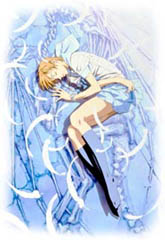 |
 |
|||||
 |
||||||
 |
||||
 |
||||
 |
||||
|
ENTERTAINMENT The Undertow of Fate - a Musical Odyssey By Christopher C., age 16, Fredericton High School, Fredericton, NB Escaflowne: Happiness and despair; classical orchestra and techno; the juxtaposition of polar opposites stands as the foundation of this moving album.
The stark emotional depth dealt with in the movie is portrayed with stunning accuracy in the soundtrack. A sorrowful string quartet will evolve into an uplifting finale; a happy, upbeat track will be led by a mournfully crooning acoustic guitar. The duality on which the album's concept was built is ever-present. The songs run an emotional gamut – where 'Horse Ride' is an almost campy heroic ballad, complete with trumpet fanfare and flourishing violin solos, 'Bird Song' is music in its simplest form; it consists of a single woodwind harmony, played by one instrument. Song 26, a 'hidden' track, comes as close to conventional western music as anything on this album (overlooking the Japanese lyrics.) In it, an unaccredited female vocalist, presumably Shanti Snyder, sings in a style reminiscent of Alecia Keys, with only a piano to back her. Though each track has its own defining elements, two strike the writer as being particularly memorable. In the first, 'Sora', we hear Snyder harmonizing with a curious-sounding synth effect. This effect is quickly replaced by a subtle piano movement, which, in the song's climax, is accompanied by a harpsichord, an ethereal chorus, and a barely-audible electric guitar. The second, 'Sora's Folktale', begins with a faint synthesizer whispering the ambience. It is soon joined by a heavily-manipulated percussion set, and female singer Midori all but breathing her indistinguishable lyrics into the song. As the track winds down, her vocals are accentuated by – of all things – an accordion (which actually sounds much better than it looks on paper.) The songs – 26 in all – were performed by the world-renowned Warsaw Philharmonic Orchestra, the Masatsugu Group, and the Osamu Matsumoto Group, among others. Producer Yoko Kanno, known for his work on Gundam Wing, lent a hand by adding piano and keyboard movements. Hajime Mizoguchi, a nigh-legendary Japanese musician, also contributed cello, keyboard and synth manipulations – possibly the most attention-grabbing aspect of the recording. Most of the tracks are instrumental, though there is a handful with Japanese lyrics performed by Maaya Sakamoto, Shanti Snyder, and Midori. This album comes highly recommended to fans of anime, neoclassical music, and concept albums. The skill with which it was crafted, in my opinion, has not been surpassed by anything of its genre. Like the movie, this record deals with the despondence felt by many teenagers today. Ultimately, though, it has a theme of life-affirmation, which is translated unspeakably well into song.
|

